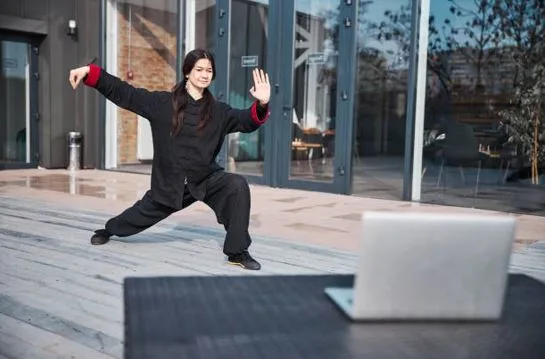Modern Students, Ancient Art: Can You Truly Learn Kung Fu Online?
Introduction — Bridging Centuries with Screens
For generations, kung fu lived in the space between teacher and student—transmitted through touch, timing, and shared silence. Today, that same art is being explored by people logging in from Berlin apartments, Texas ranches, or Tokyo studios. The tools have changed, but the question remains urgent: can real kung fu be learned when the only connection is a Wi-Fi signal? The answer depends not on technology, but on whether the practice still meets the timeless conditions that make it work.
Motivation and Mindset — The True Starting Point
No amount of video access will carry someone through years of subtle, often invisible progress. As one teaching resource puts it plainly: “Superficial study will not yield results, no matter how long one has been practicing.” Real training demands a clear reason to keep going when the novelty wears off. It’s not about wanting to “try kung fu”—it’s about deciding to live with its demands. Without that internal anchor, even daily logins become empty ritual. The first step isn’t choosing a platform; it’s asking yourself how much you’re truly willing to give.
Mentorship Beyond Walls — Learning with Guidance
A mentor isn’t just an instructor—they’re a mirror. They see the habits you can’t, correct the misalignments you don’t feel, and name the principles you haven’t yet grasped. “The knowledge you gain from a mentor… touches on aspects that go beyond intellectual understanding,” notes a guide on authentic training. While a screen can’t replace hands-on correction, it can carry a teacher’s explanations—if those explanations go beyond “do this” to “here’s why this works.” When video lessons unpack body mechanics, intention, and structure, they become more than recordings; they become a form of distant guidance.
Consistency and Progression — Why Structure Matters
“Train for a day—gain for a day; skip a day—lose ten days.” This isn’t folklore—it’s how the nervous system builds skill. Daily practice forges connections that irregular effort cannot. But repetition alone isn’t enough. Training must follow a sequence: posture before power, stillness before response, awareness before application. Jumping ahead creates illusion, not ability. A strong online program respects this order, offering a curriculum that builds layer by layer—just as traditional schools do. Without that scaffolding, students collect techniques like souvenirs, never assembling them into a working whole.
Online Classes That Make Sense — From Videos to Real Skill
Not all digital offerings serve real learning. Some flood users with content; others offer a path. A thoughtful example is the tiered access available through membership online classes. The basic level gives learners room to explore at their own pace. The advanced option adds “How It Works” videos—short, focused lessons that reveal the logic behind movements, not just their shape. This distinction matters. It turns passive watching into active inquiry, letting students return to the same concept again and again until it clicks in the body, not just the mind.
Attention, Awareness, and the Quality of Practice
Movement without awareness is just motion. What separates kung fu from calisthenics is the quality of attention brought to each second of practice. “With a superficial amount of attention, we hear very little,” the source material warns. True training means tracking breath, weight shift, tension, and intention—not as separate tasks, but as one flowing awareness. At home, with no teacher to call out distraction, this becomes the student’s responsibility alone. The screen doesn’t create focus; it reveals whether you have it.
Conclusion — Ancient Art, Modern Paths
Yes, kung fu can be learned online—but only if the student brings seriousness, the method is structured, and the teaching goes beyond demonstration to explanation. Technology doesn’t replace tradition; it redistributes the burden of discipline. The art remains unchanged. What’s different is who shows up—and how honestly they’re willing to listen. For those ready to meet the practice on its own terms, the path is still open. It just starts with a click instead of a bow.




